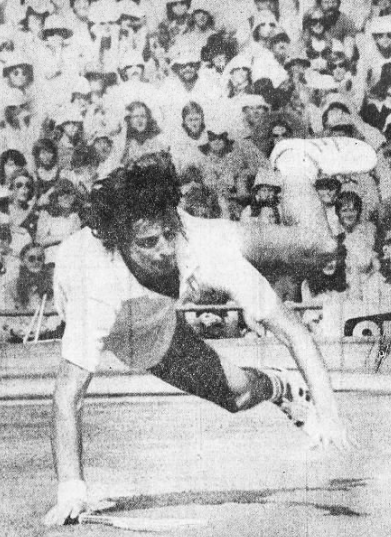When 23-year-old Jiří Hřebec arrived in Australia for the 1973 Davis Cup semi-final, he was coming off the best win of his career: a five-set triumph in Prague over his countryman, Cup teammate, and idol Jan Kodeš. He followed it up–albeit after a three-week break–with another career highlight, an upset win in Melbourne over reigning US Open champion John Newcombe.
Going into that match, Hřebec said, he gave himself a 30 percent chance of winning. That’s confidence for you: Few of the 11,000-plus fans at Kooyong would have given the unknown Czech so much as a 3 percent shot. Yet in four focused sets, the youngster knocked out one of the best players in the game to even up the Davis Cup tie at one rubber apiece.
The Aussies came through a grueling doubles match the next day, and the no-longer anonymous Hřebec was on the hot seat again. On November 18th, he faced none other than Rod Laver in an elimination match. If Laver won, Australia would advance to play the United States for the trophy. If Hřebec pulled off another miracle, the tie would come down to a decider between Newcombe and Kodeš.
On paper, it was a near-guarantee for the lads from Down Under. Hřebec refused to see it that way.
In a tight first set, the Czech made the first move, breaking in the 11th game for a 7-5 opener. He eased up a bit to start the second, and the wily Laver pounced. The 35-year-old Rocket had played seven sets in the previous two days, but he had enough energy to secure two more in succession, 6-3 and 6-4. Hřebec’s game was, according to the Melbourne Age, “not quite so exciting or brilliant” as it had been against Newk, but he didn’t back down, taking the fourth set 6-4.
Once again, Laver immediately seized the advantage after his opponent won a set. In the decider, he broke in the first game and ran out to a 5-2 lead. Hřebec, however, just wouldn’t give up. He needed just five points to break back, then held serve for 5-4. The Australian crowd couldn’t help but cheer on the underdog. Even when Laver took the tenth game to a 40-0 lead and triple match point, Hřebec lashed a cross-court forehand to wrong-foot the Aussie, then came up with one of the best shots of the match, a diving drop-volley that left him sprawled on the ground.
Only then did Rocket fire off an unreturnable serve and complete the victory, 5-7, 6-4, 6-3, 4-6, 6-4.
Laver was unique in the admiration he inspired from opponents. Hřebec declined to speak to the press–his English wasn’t good and besides, it was Australia’s day–but he provided a written statement: “[T]o play the tennis that Laver played today under that sort of pressure was magnificent.”
As for Hřebec, he had turned in his third consecutive career highlight. Never again would an Aussie underestimate him.
Australia had waited a long time to return to the Davis Cup finals. Laver hadn’t played for his country since 1962; Ken Rosewall, incredibly, hadn’t been eligible to suit up since 1956. The competition maintained a ban on “contract” professionals, players who received an annual guarantee from the World Championship Tennis circuit. The restriction had severely limited the pool of Davis Cup players since 1968, but as the economics of the game shifted, stars stopped signing long-term deals and competed strictly for prize money. Laver’s and Rosewall’s contracts had each run out before the 1973 campaign.
After five years in the Davis Cup wilderness due to what it viewed as an unreasonable rule, Australia wanted to win it the right way. Two of the few remaining contract pros, Arthur Ashe and Cliff Richey, were Americans, and both were strong enough to merit a place on the United States squad had they been eligible. Immediately after Newcombe polished off his dead rubber against Kodeš, team captain Neale Fraser invited the Americans to use anyone they wished, including Ashe or Richey.
In two days, the Aussies departed for Cleveland, Ohio, to begin their preparations for the last hurdle. The Davis Cup had, for decades, been the defining competition of the sport of tennis, and no country had mastered it like Australia. The 1973 championship round would, for the first time in years, pit the best against the very best. Laver, revitalized after a frustrating season, was ready to lead one final charge.
* * *
This post is part of my series about the 1973 season, Battles, Boycotts, and Breakouts. Keep up with the project by checking the TennisAbstract.com front page, which shows an up-to-date Table of Contents after I post each installment.
You can also subscribe to the blog to receive each new post by email:
